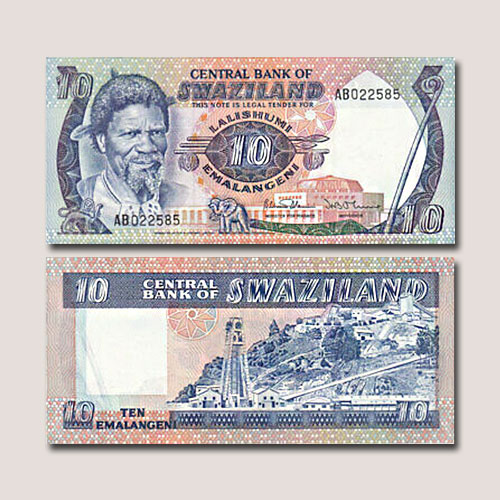Swaziland 10 Emalangeni banknote of 1985
2019-12-04 Wed
Swaziland, recently renamed as Kingdom of Eswatini in 2018, is a small, landlocked monarchy in southern Africa. It is known for its wilderness reserves and festivals showcasing traditional Swazi culture. Marking its northeastern border with Mozambique and stretching down to South Africa, the Lebombo Mountains are a backdrop for Mlawula Nature Reserve’s many hiking trails. Nearby Hlane Royal National Park is home to diverse wildlife including lions, hippos and elephants.Swaziland was under Great Britain for more than 60 years, until they got independence in 1968. The name change happened on the 50th anniversary of independence from Britain and the king’s 50th birthday. The king announced that African countries started using their original ancient names after independence and that Swaziland will be now officially known as the Kingdom of eSwatini.
The Swaziland Lilangeni (singular, emalangeni: plural) is the national currency of the Kingdom of eSwatini. It is subdivided into 100 cents and issued by the Central Bank of Swaziland (renamed as Central bank of Eswatini).
Today we are looking at a 10 Emalangeni banknote issued in 1985. The obverse depicts the portrait of King Sobhuza II to left and the Parliament building in Lobamba to right centre. Below the portrait are depicted a lion (as a symbol for the King) and an elephant (as a symbol for the Queen) along with shield and spears in centre with denomination written on it.
The reverse depicts Havelock Asbestos mine at Bulembu (Emlembe), west of Piggs Peak at the South African border. This multi-coloured note has traditional Swazi shield and spears as its watermark.
Image Courtesy: PicClick
Latest News
-
Malwa Sultan Mahmud Shah Silver Coins
2025-09-11 ThuMalwa Sultan Mahmud Shah minted silver coins in round and square flans. <br><br> For round coins,...
-
Malwa Sultan Mahmud Shah Billon coin
2025-08-26 TueMalwa Sultan Mahmud Shah's billon coins followed three weight standards: 100 rati, 96 rati, and 80 r...
-
Fascinating Archaeological Facts on Postage Stamps - 91
2025-08-23 SatRhinoceros is one of the oldest land mammal species existing in India. There are five species of rhi...
-
Fascinating Archaeological Facts on Postage Stamps - 90
2025-08-23 SatUthiramerur, a Village in Kanchipuram, Tamil Nadu, is notable for its Temple inscriptions that descr...
-
Fascinating Archaeological Facts on Postage Stamps - 89
2025-08-21 ThuThe term “millet” is derived from the Latin word “milum,” which translates to grain. millets...

